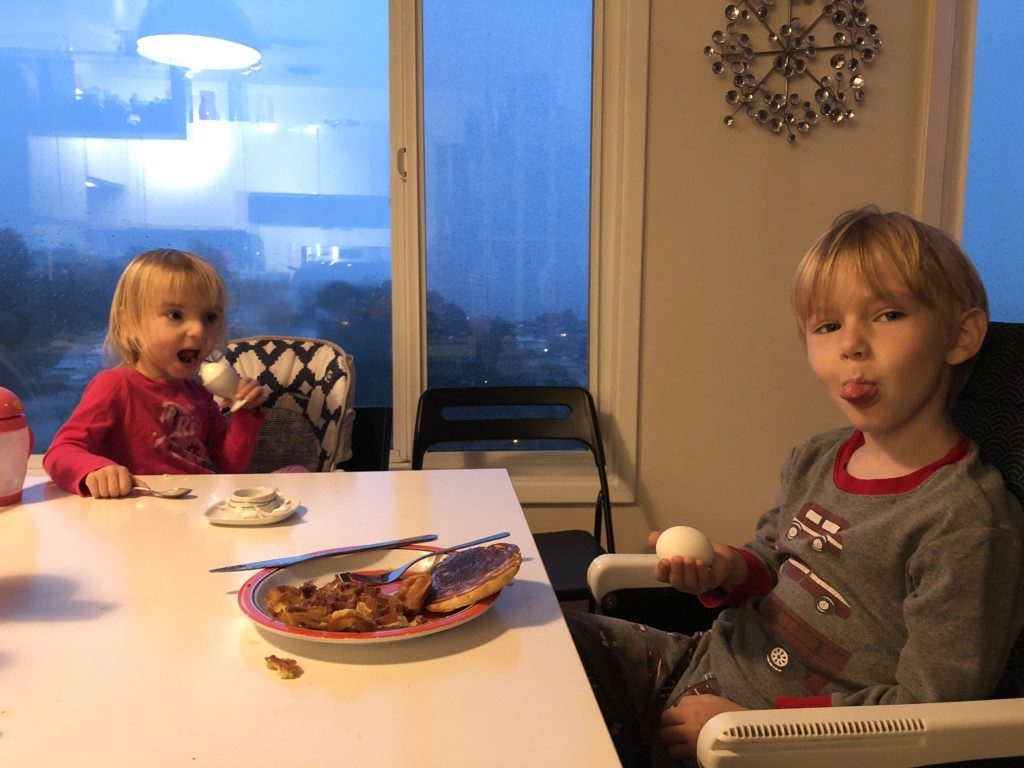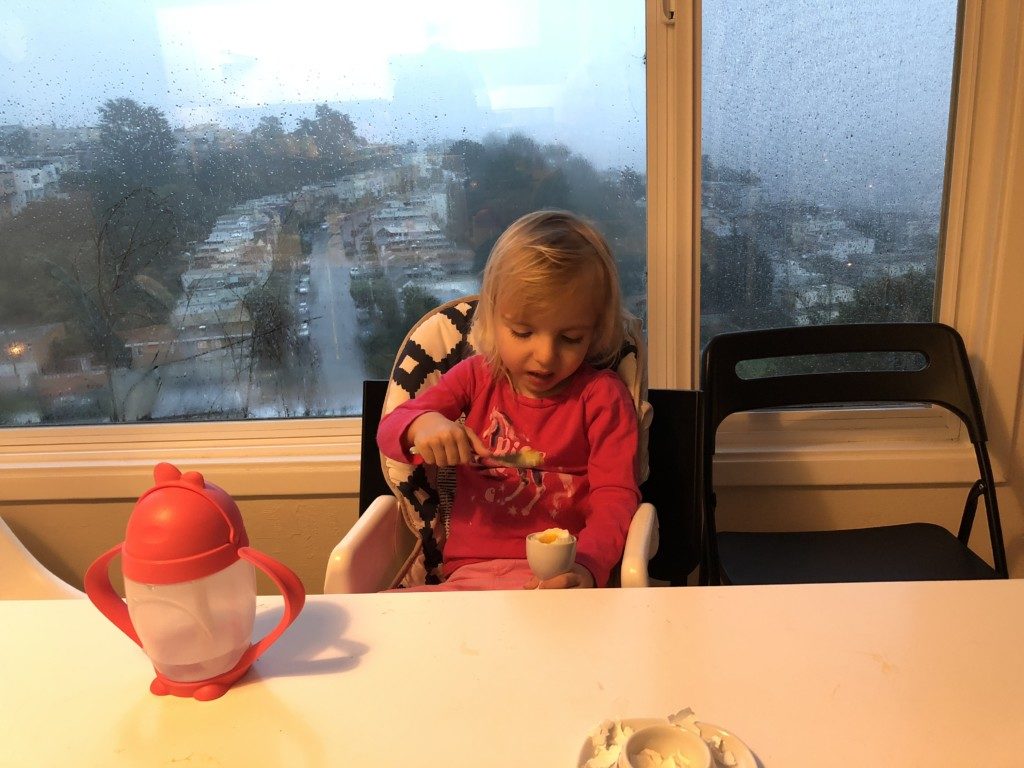
You might think your toddler is a tough case when it comes to getting him or her to sit down and eat, but your kid ain’t got nothin’ on mine. My daughter has a full-on feeding aversion, and here is my story of helping her overcome it.
What is a feeding aversion?
Feeding aversion is a condition where a child refuses to take nourishment even though there are no functional barriers to eating. We’re talking serious resistance to eating, where the kid would rather go hungry than take a bottle or a bite.
Also known as oral aversions, this is a problem that often affects preemies, autistic children, and children who needed feeding tubes as babies. It’s like getting a double whammy — at first, you think you’re dealing with one situation and then this other one sneaks up when you aren’t paying attention.
Getting past the first hurdle
It’s a little after 9:00am on Monday, April 3rd, 2017. I’m in the kitchen with my daughter, Roxanne, who is strapped into her high chair, and Dr. Meeta Patel and Vicky Pham, who are seated on either side of Roxie. It’s Roxanne’s first feeding therapy session with Clinic4Kidz.
By the time we start working with Dr. Patel’s clinic, Roxanne is 16 months old and will neither hold a bottle to drink milk nor allow anyone to feed her any type of food. It is more than just being a picky eater. She gets all of her calories via a feeding tube installed in her tummy, called a G-tube.
Dr. Patel presents Roxie with a spoon with a little bit of fruit puree’ on it and asks her to open her mouth. Roxie twists her head away and clamps her mouth shut. The therapists are firm, and Roxie gets worked up and starts crying. I go in the other room, unable to bear the scene.
A moment after I leave, I hear a burst of happy praise from the doctor and the therapist. Roxie has taken her first willing bite of food. Another urge to open, then another burst of praise.
The feeding over, I go back into the kitchen and sit down to hear Dr. Patel’s assessment for what the treatment plan will look like.
A protocol for everything
Since Roxanne hasn’t done very much with her mouth ever — she even dislikes pacifiers — she lacks a lot of the coordination needed for eating and drinking. So, part of the treatment involves activities to help her build up those muscle movements. In addition, she is a smart girl and has learned a lot of resistant behaviors that have to be countered.
This is basically how the therapy works: The therapists figure out how to get Roxie to take a bite of whatever is presented to her, and then reinforce that with praise and other positive feedback. It’s all about breaking the bad habits and replacing them with good ones. They start by training Roxie, and then they train us, her caregivers.
There are a ton of nuances to getting a resistant kid to eat. Over time, my partner and I are taught how to hold a spoon in just the right way to get Roxie to open her mouth almost automatically, how to watch her body language for signs that her stomach is reaching capacity, and so on. We are taught things to say and given a meal plan. We have to write everything down so that the regimen can be adjusted to perfect it and adapt it as Roxanne grows and learns.
How the aversion started
Roxanne’s feeding problems started when she was a preemie with chronic lung disease that made it impossible for her to get through a feeding session without tiring out. For this reason, she had a nasogastric tube (NG tube) for supplementing her calories.
Then the acid reflux started. She threw up her milk sometimes after every single feeding, which meant that she was throwing up as much as eight times a day.
We had many discussions with nurses, therapists, and doctors about what might have been causing it. Were the feedings too fast? Too much in one feeding? Was it lactose intolerance? Was the NG tube irritating her throat and triggering her gag reflex? Was it one of her medications? Were we doing a bad job of burping her? I doubt Dr. House could have figured it out.
We learned a bunch of new ways to say vomit. Spit up and emesis were the two nice ones that I learned from the nurses at the NICU. We also got really good at catching stuff as it came out.
For the record: the perfect barf bag is a gallon-size Ziploc bag with the top cuffed down.
From then on, our daughter refused to take a bottle. She would cry, turn her head, clamp her mouth shut and bat it away with her hands. At about one year of age, the acid reflux cleared up and the vomiting stopped, but Roxie would have nothing to do with eating.
[easy-image-collage id=5543]
Panic that my kid might never eat
When we first brought our daughter home from the hospital, the doctors at the NICU had assured us that once she was settled in at home, she would likely get caught up on bottle feeding. But that never happened. For months, I kept hoping that one day she would suddenly start guzzling down her milk and the troubles would be over.
Then, I met a 6-year-old girl in the pediatric ward who wore a little backpack and had to have a tube going to her stomach that dripped formula to her all day long. Her mom said that she was pretty much allergic to everything. That made me realize that we might be in this for the long haul, and I became determined to do everything we could to find better help.
We started researching everything we could find online about who could help our daughter start eating and get off the G-tube.
 Where we looked for help
Where we looked for help
We spoke with our daughter’s doctors first: the pediatrician, the nutritionist, the pediatric gastroenterologist. They had her evaluated by a speech therapist who pronounced a feeding aversion and recommended feeding therapy.
So, we started with the feeding therapist that was part of our medical network. She was a wonderful person, but her method was very gentle and made no progress for months on end.
We then started looking beyond our medical network. We spoke to someone at the Seattle Children’s Hospital feeding clinic, which has a very well-respected program. Unfortunately, they only could accept children living in their local region because they have such a long backlog.
We found a clinic based in Austria that specializes in helping children get off their tube. They even offered an online therapy program that looked promising, but our daughter’s medical condition wasn’t stable enough for them to accept her.
Then we were referred to the Clinic4Kidz, who was described to us as the “therapy of last resort” for all Bay Area children with eating problems. The head of the program, Dr. Patel, came by our house to evaluate her and we went onto the waitlist. Six months later, we started therapy.
Down the long road of rehabilitation
Anyone with a child with special needs knows that the road to recovery is long and full of setbacks. Time and consistency are the only things that make a real difference.
Roxanne has been in the Clinic4Kidz program for one and three-quarters years (it will be two years this coming April). She still has a G-tube and still receives a portion of her daily calories from formula dripped into her at night while she sleeps. But thanks to the constant small improvements in her behavior and eating abilities she has put on weight and moved up the growth chart, from the 1st percentile for weight to now the 10th.
There have been many setbacks, especially in the winter months during cold and flu season. But she has still managed to come a long, long way with her eating. She eats on her own. She has a wider repertoire of foods she’s willing to eat than her big brother, who is going on five and is just a picky eater.

Training Roxie to eat has turned into an opportunity for me to learn to be a better parent. It was hard for me to accept that the feeding aversion couldn’t just get fixed once and for all. However, kids with special needs are not like cars that just need a quick trip to the mechanic to repair them and get them back on the road.
Instead, they need the people who are taking care of them to pay attention all the time to how they are doing, physically, and emotionally. Things might be fine one day and difficult the next, and it’s always a puzzle to figure out what to try in any particular moment. And it sounds a little corny to say it, but often the missing piece is just extra loving hugs for everyone all around.
[hr]
 About Leslie
About Leslie
Leslie is a mom, children’s author, and marketing executive who lives with her family in San Jose, CA. By day she develops corporate communications designed to resonate with grown-up audiences, and by night she crafts stories to settle her kids into bed that often get them too wound up to sleep. She posts stories for kids and for parents at her blog, https://stories.leslievanzee.com.


















